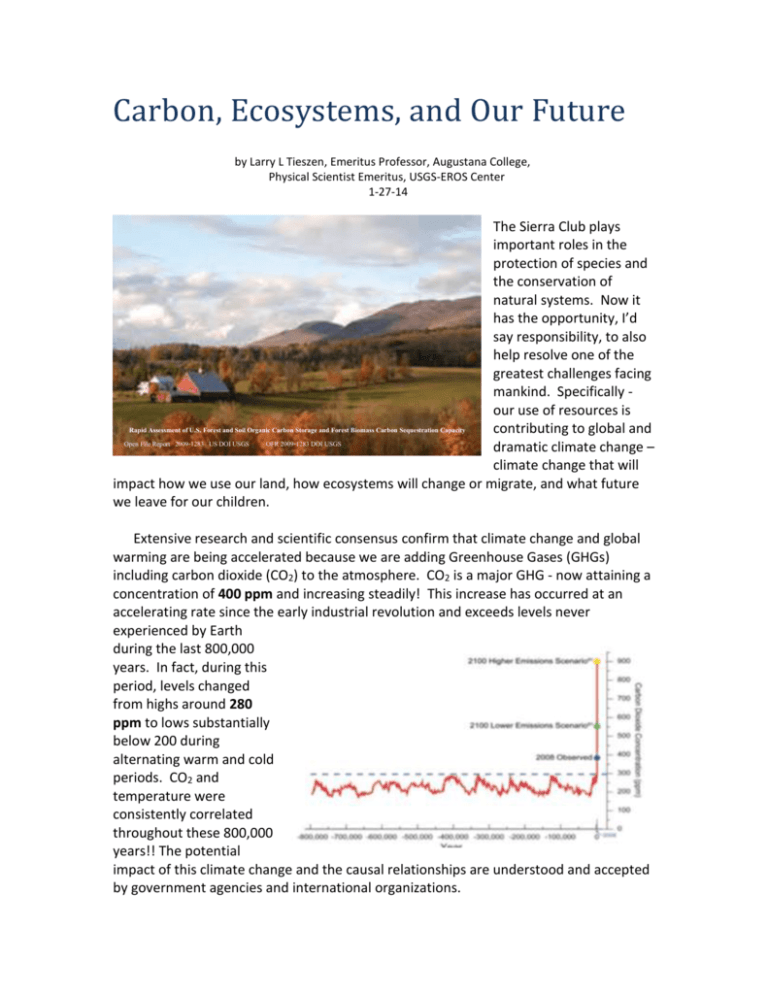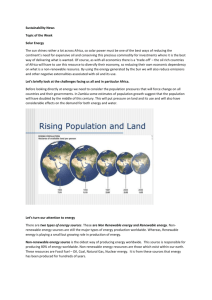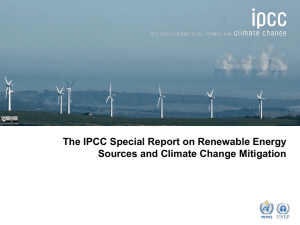future we leave our children
advertisement

Carbon, Ecosystems, and Our Future by Larry L Tieszen, Emeritus Professor, Augustana College, Physical Scientist Emeritus, USGS-EROS Center 1-27-14 The Sierra Club plays important roles in the protection of species and the conservation of natural systems. Now it has the opportunity, I’d say responsibility, to also help resolve one of the greatest challenges facing mankind. Specifically our use of resources is Rapid Assessment of U.S. Forest and Soil Organic Carbon Storage and Forest Biomass Carbon Sequestration Capacity contributing to global and Open File Report 2009-1283 US DOI USGS OFR 2009-1283 DOI USGS dramatic climate change – climate change that will impact how we use our land, how ecosystems will change or migrate, and what future we leave for our children. Extensive research and scientific consensus confirm that climate change and global warming are being accelerated because we are adding Greenhouse Gases (GHGs) including carbon dioxide (CO2) to the atmosphere. CO2 is a major GHG - now attaining a concentration of 400 ppm and increasing steadily! This increase has occurred at an accelerating rate since the early industrial revolution and exceeds levels never experienced by Earth during the last 800,000 years. In fact, during this period, levels changed from highs around 280 ppm to lows substantially below 200 during alternating warm and cold periods. CO2 and temperature were consistently correlated throughout these 800,000 years!! The potential impact of this climate change and the causal relationships are understood and accepted by government agencies and international organizations. The UNFCCC recognized this in Rio in 1992 when they (195 countries and the US) agreed: “THE ULTIMATE OBJECTIVE….IS TO ACHIEVE… STABILIZATION OF GHG CONCENTRATIONS…. AT A LEVEL THAT WOULD PREVENT DANGEROUS ANTHROPOGENIC INTERFERENCE WITH THE CLIMATE SYSTEM” 400 ppm today todaytodTodtod ay So how have we un-stabilized this system? Why are we emitting CO2 and increasing the atmospheric concentrations? Let us look at the pools (stocks) and fluxes of C. Five major global pools of C are important: Global Pool 1. Vegetation 2. Soils 3. Atmosphere 4. Oceans 5. Fossil Fuel Petagrams Carbon (Pg) 560 1500 750 38000 4000 Major Human Impacts Loss of wetlands, grasslands or forests Loss due to agriculture and deforestation (modern ag can reclaim) Dramatic increase due to human induced emissions from 5, 1, and 2 Surface increasing and becoming acidic Decreasing due to human use In an unperturbed system the atmosphere receives emissions from plant and soil respiration which is in near balance with photosynthetic uptake of C. The same for the oceans. Note the large amounts in soils and in fossil fuels. Early land use change from grasslands and forests to agriculture resulted in losses of C, by oxidation, from these ecosystem pools to the atmosphere. Some of this continues today, especially in certain parts of the world. However, even in the Great Plains, conversions from grassland or CRP land back to corn usually result in the loss of soil C to the atmosphere. Yes, grain prices and government programs drive C fluxes and emissions. More recently, since early industrial times, we have mined fossil fuels. Their use today is the large contributor to the rapid increase in atmospheric C!! Even if emissions were to stop today, much of the C would remain in the atmosphere for a long period and continue global warming!!! So, what are our options? We have initiated this trend, which will, unfortunately, continue. So we must plan for the future. ADAPTATION is essential for our children and theirs, unfortunately. Meanwhile we must also continue to emphasize MITIGATION. We need to reduce our increasing emissions of C to the atmosphere, yes, not only to the rates of emissions we cause today, but ultimately to ZERO. Even this will result in substantial GHG effect because of the current C levels in the atmosphere and the long residence time of C. What can the Sierra Club do? We must recognize that climate change will happen and that we humans are largely the cause because of our emissions of C. We should explain this as clearly as we can. We need to recognize that some natural systems will migrate as ecosystems, species and crops are impacted by climate change. Conserved natural areas may have to move!! We need to quantify the impacts of land use on C fluxes. Encourage support for conservation of wetlands, stream borders, native grasslands, and forests so they maintain and grow their C stocks. Provide support for sustainable agriculture where sustainability includes the maintenance of soil C. We can capitalize on recent developments that include high yielding crops, remote sensing, and carbon flux measurements to help quantify the ability of agriculture to become a net sink for C, as is now happening in some areas. The Sierra Club should encourage legislation that provides farmers and landowners support for conservation areas that avoid emissions by retaining wetlands, establishing natural grasslands, or protecting natural systems. All these efforts become more important as we provide strong support for the replacement of fossil fuels with renewable energy sources and retain Earth as a habitable system!







